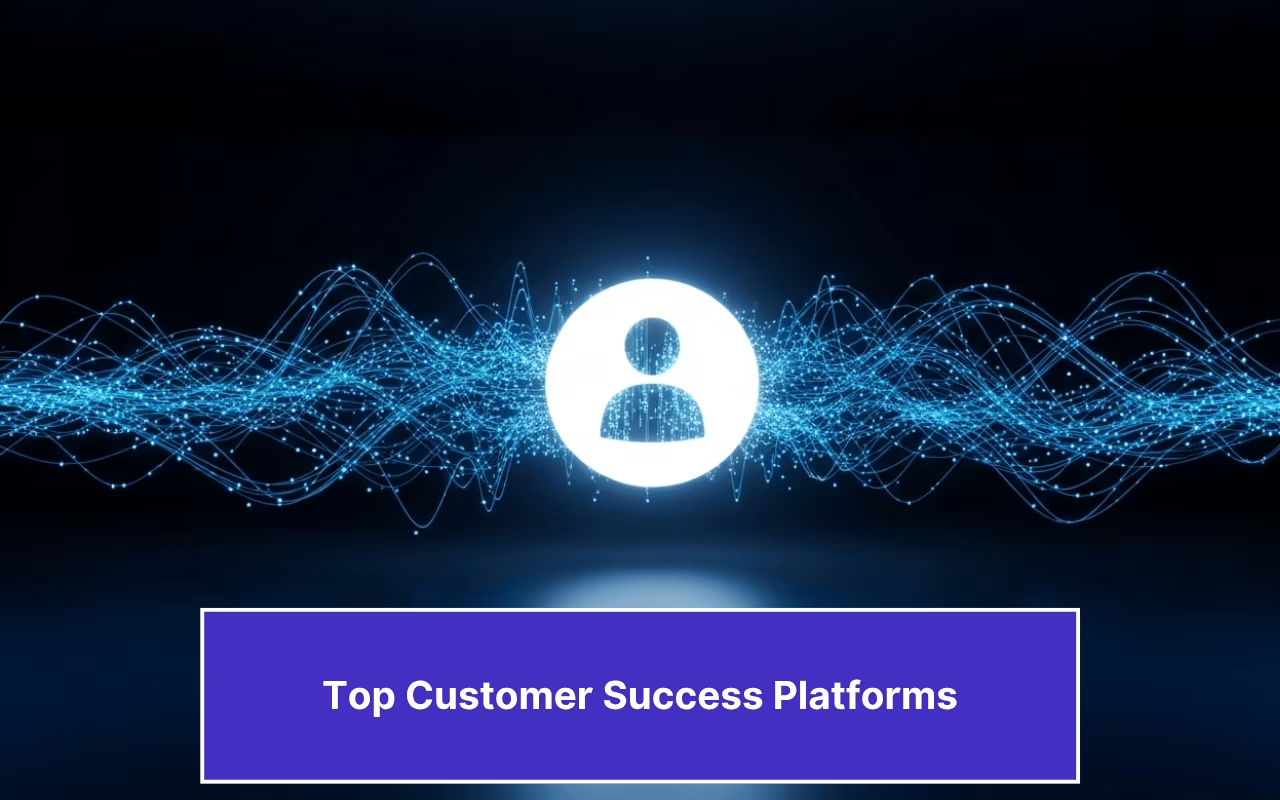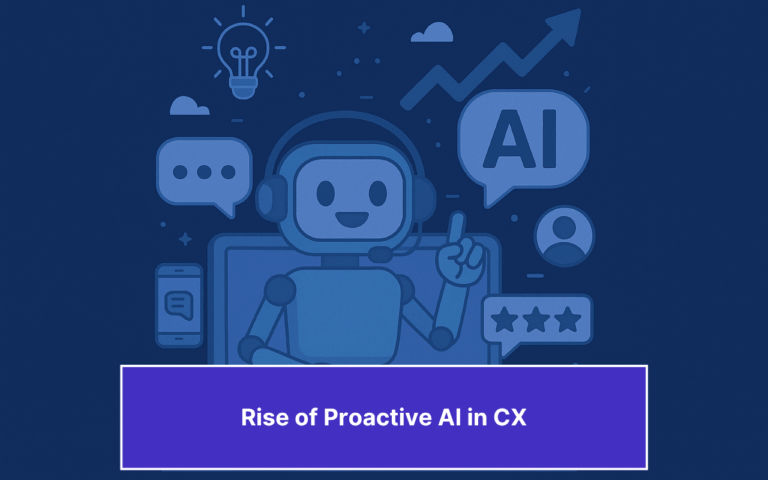Updated on March 17, 2025
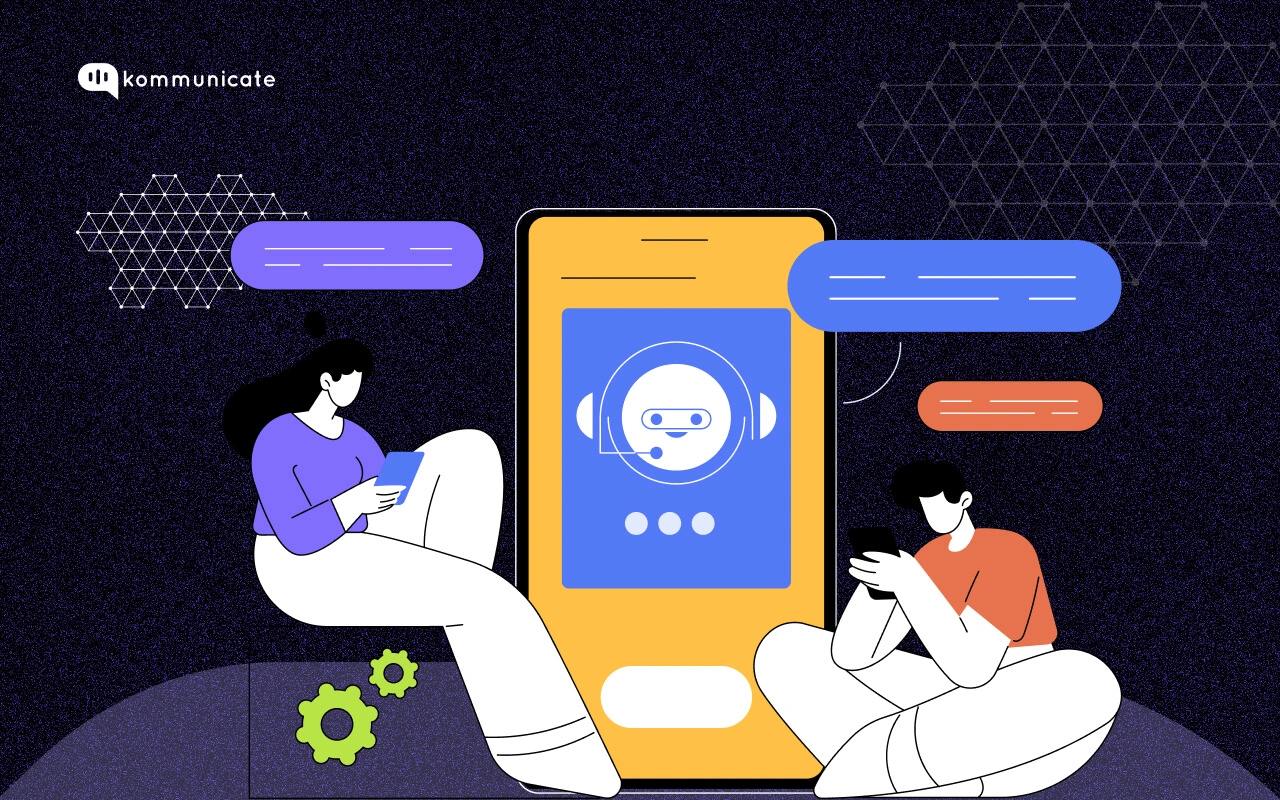
Table of Content
- Chatbots – The forefathers of modern-day LLMs
- Rise of Large Language Models
- How LLMs Chatbot Improve Customer Support
- Challenges of using LLMs Chatbot in customer support
- Best Practices for integrating LLMs in chatbots
- Real-Life Use Cases of LLMs Chatbot in Customer Support
- Conclusion
If you ask any business owner about the area that they would most like to automate, in a majority of cases, it would be customer support automation. AI-powered customer service chatbots, virtual assistants, and today, LLMs for customer support, all are competing against the headset-wearing bunch.
And with AI-powered LLMs, it looks like the customer service automation landscape has transformed significantly. Dukaan, an eCommerce company in India, for instance, recently fired over 90% of its support staff to replace them with an AI-powered chatbot for customer support .
While this caused a lot of furor online, it looks like this is just the beginning of an increasingly worrying trend. Companies like Google and Amazon are also implementing AI in a big way, leading to large-scale job loss.
So are LLMs the future of customer support? Let’s find out.
Before LLMs made a splash thanks to the whole OpenAI ChatGPT episode, there was a forerunner. Yup, if you haven’t guessed it by now, it’s chatbots!!
Do you want to find out more about the customer service chatbot? Check out these articles:
- Create A Customer Service Chatbot Using ChatGPT
- 13 Ways Chatbots are Improving Customer Service
- How Customer Service Chatbots Can Improve The Customer Experience
Chatbots – The forefathers of modern-day LLMs.
Now we all know what chatbots are, and how with tools like Kommunicate, you can be up and running with a chatbot in less than 10 minutes. But building chatbots is just one part of the puzzle. How effective were chatbots in providing actual customer support?
Turns out – chatbots were great when it came to providing customers with instant responses and were seen as an excellent way to provide stellar customer service.
The advantages of using chatbots in customer support are manifold. Chatbots don’t get tired, chatbots provide instantaneous responses, chatbots can be personalized, chatbots can be used to collect leads, and the list goes on and on.
The evolution of chatbots ran parallel to that of customer support, and, you can say, some of the key advancements in chatbot technology were made to enhance use cases such as that of customer support.
Natural Language processing, or NLP as it is commonly called, is one such advancement. NLP chatbots bridged the gap between consumer expectations and brand communication. NLP chatbots “understood” human speech and it provided a human response to the queries, blurring the line between technology and an actual human being at the other end of the chat.
However, there were drawbacks to NLP chatbots. NLP chatbots still have to be trained, and this training has to be effective. Companies still have to employ deep machine learning algorithms to impart comprehension capabilities to the chatbot. If this is not done right, the chatbot will be robotic – cold and ineffective.

Another drawback of NLP chatbots is that they don’t understand some of the subtle nuances of human language – like sarcasm or humor. Drawbacks like these, and the fact that you need deep technical expertise to build an NLP chatbot, made them inaccessible to the smaller players in the market.
And this is where LLMs stepped in.
The Rise of Large Language Models – ChatGPT and Beyond…
ChatGPT did something that a few pieces of technology have done in the past – it revolutionized the entire tech space. Just like the smartphone and the internet before that, ChatGPT was a quantum leap in the realm of what was possible with technology.
OpenAI’s launch of ChatGPT in late November 2022 heralded a new era. Many people called it the Google killer. Google itself went into offensive and started working on its own LLM, along with big names such as Meta and Anthropic.
Competition is always good- especially in the tech space, where large organizations are now scampering to get their LLMs in front of users. ChatGPT and Gemini (from Google) are the forerunners in this race at the moment, but things change fast.
LLMs are powered by massive language datasets and advanced machine learning algorithms, and have far surpassed their predecessors – chatbots. Unlike chatbots, LLMs can understand the nuances and context of natural language and are learning all the time. If there is a customer query that the LLM is unable to understand, you can bet that it will be on the lookout for an answer and train itself when it finds a solution.
GPT4, the latest from OpenAI, is a quantum leap when it comes to AI-powered customer support chatbots. GPT4 can surf the web for answers and is trained on petabytes of data, making it one of the most powerful AI chatbots for automated customer service. It excels in comprehending nuanced text, and with 10 trillion parameters, GPT-4 is the ultimate tool for any customer support team.
Enhance customer support with AI-driven email ticketing – automate workflows and resolve queries faster with Kommunicate!How LLMs Chatbot Improve Customer Support
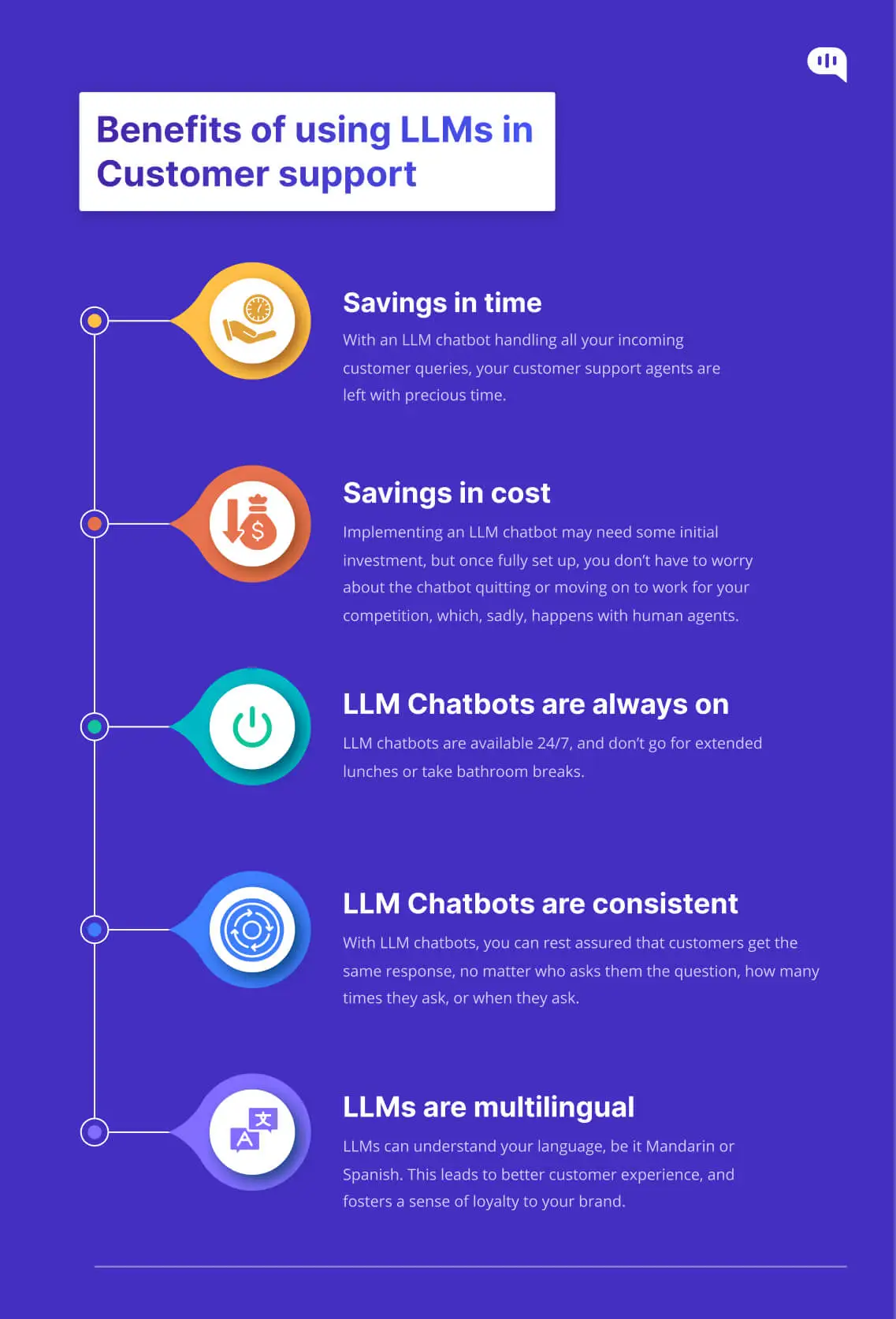
LLMs are powerful tools that, if used correctly, can improve the quality of customer support by leaps and bounds. Let us now take a look at some of the benefits of using LLMs in customer support:
- Savings in time: The game of customer support is all about who can resolve the query of the customer the fastest. With an LLM chatbot handling all your incoming customer queries, your customer support agents are left with precious time. Time which they can use to solve the more challenging queries.
- Savings in cost: Implementing an LLM chatbot may need some initial investment, but once fully set up, you don’t have to worry about the chatbot quitting or moving on to work for your competition, which, sadly, happens with human agents. There is thus tremendous savings in training and hiring costs, which you can invest in R&D or marketing your product.
- LLM Chatbots are always on: What we mean to convey is that LLM chatbots are available 24/7, and don’t go for extended lunches or take bathroom breaks.
- LLM Chatbots are consistent: When it comes to customers getting a consistent response, human agents are notoriously unpredictable. But with LLM chatbots, you can rest assured that customers get the same response, no matter who asks them the question, how many times they ask, or when they ask.
- LLMs are multilingual: One of the key benefits of using LLM chatbots is that they can understand your language, be it Mandarin or Spanish. This leads to better customer experience and fosters a sense of loyalty to your brand.
Challenges of using LLMs Chatbot in customer support
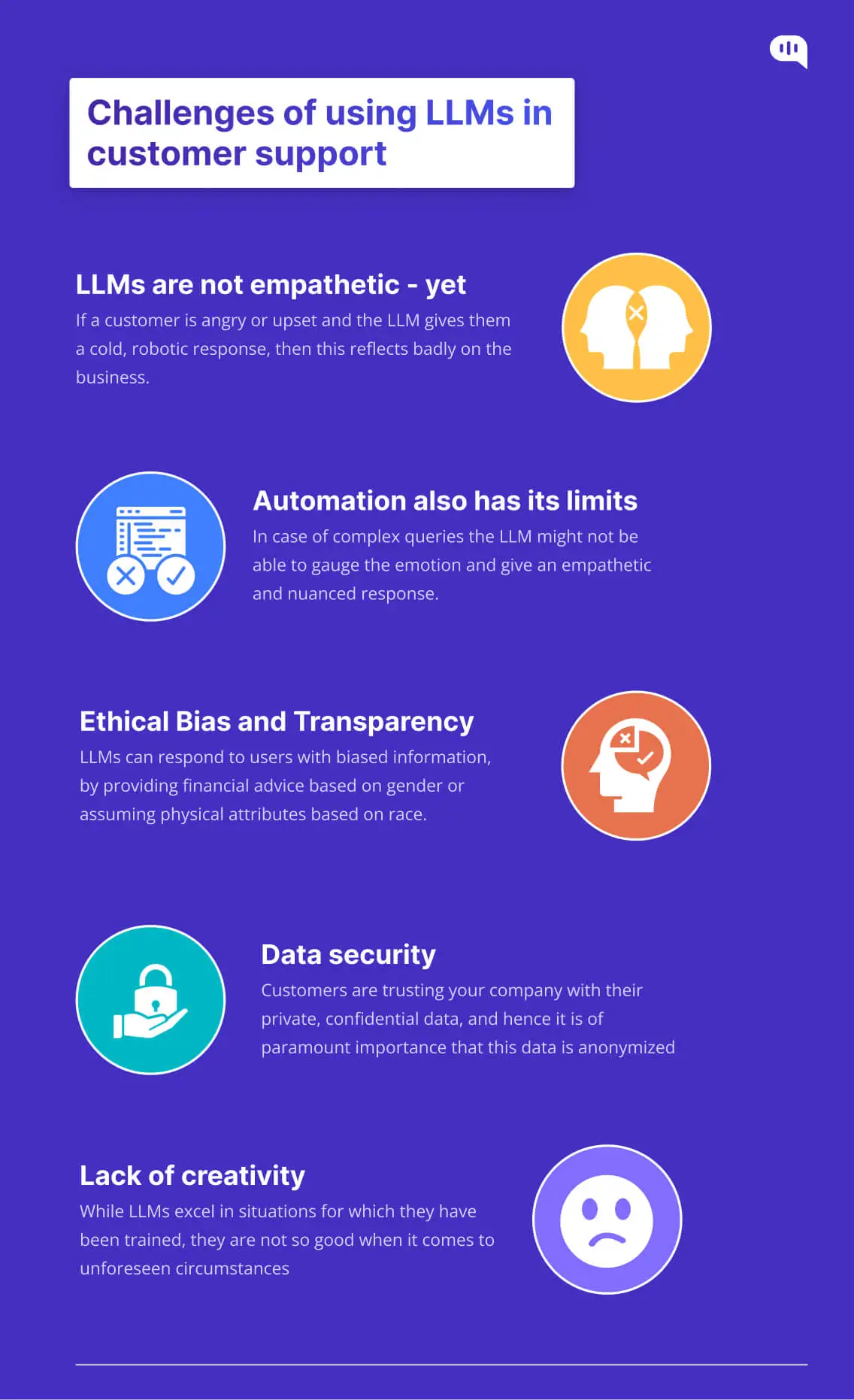
- LLMs are not empathetic – yet: The one major trait that a customer looks for in a support agent is empathy, and this is something that LLMs have not yet been able to achieve. If a customer is angry or upset and the LLM gives them a cold, robotic response, then this reflects badly on the business and eventually, leads to a poor customer experience.
- Automation also has its limits: As an offshoot of the previous limitation, LLMs are still not able to address extremely complex queries. For tricky situations, like a customer coming to a chatbot asking for financial advice, the LLM might not be able to gauge the emotion and give an empathetic and nuanced response. In these cases, a human agent is always a better option.
- Ethical Bias and Transparency: The training for LLMs happens on vast datasets, and it is only natural that societal biases and prejudices creep in. The moment it becomes dangerous is when the LLMs start to respond to customers based on the very same biases.
- Data security: Customers trust your company with their private, confidential data, and hence it is of paramount importance that this data is anonymized. In dealing with this data, you need to ensure that there are no data leaks and that clear privacy policies are in place to protect customer trust.
- Lack of creativity: While LLMs excel in situations they have been trained, they are not so good when it comes to unforeseen circumstances. Creative problem-solving is an area that the human brain, which has naturally evolved over centuries, understands well.
Now that you have seen the benefits of LLMs in customer support, let us take a look at the best practices that will ensure that your LLM chatbot is a success.

Best Practices for integrating LLMs in chatbots
Simply combining your LLM with your chatbot does not guarantee success. A thoughtful implementation is the first step to ensure that your chatbot only gives clear, concise, and coherent answers and understands the subtle nuances. Here are 5 of the best practices that you have to follow while integrating LLMs into your chatbots.
- Clearly define the What: What do you want to achieve with your chatbot? This is the first question that you must answer before implementing LLM into it. Are you building a simple FAQ chatbot or a more complicated one that provides product recommendations? Defining your goals early on ensures that you choose the right LLM.
- Craft clear dialogue flows: Your LLM is still a computer program and plays by the rules of programming. It cannot magically understand all the user queries. You must craft clear and concise dialogue flows that guide the conversation, provide context, and anticipate user intents.
- Ensure the quality of your Training data: Your LLM is only as good as the training data it was trained on. Carefully invest in training data that is a mirror of your brand voice and your desired conversational style. This will ensure that the language of your chatbot will be natural and consistent.
- Make sure your chatbot is learning continuously: LLMs are good at learning. Make sure that you implement feedback loops that will ensure that the quality of your LLM’s responses improves over time. This ensures the relevancy of your chatbot and also makes sure that it evolves along with user queries.
- Data protection and ethical considerations: Training data is susceptible to come with inherent biases, as was seen famously with earlier versions of ChatGPT. Make sure that your training data is of the highest quality, and be transparent about your data collection and usage practices.
Real-Life Use Cases of LLMs Chatbot in Customer Support
Below is a list of companies that are using LLMs in their customer support function, adopting the technology in a big way.
- Netflix and ChiLLM: Netflix is one of the companies that uses the latest in tech in all its spheres, and the results are there for everyone to see. In the third quarter of 2023, Netflix generated a whopping $24.89 billion dollars in revenue. So the question is – How are they keeping their users engaged?
Ever wondered how Netflix just “knows” the shows that you want to watch, and recommends shows that you keep enjoying? It’s not magic, or random, but powerful LLMs that are operating behind the scenes. Netflix analyzes user’s viewing patterns and understands subtle cues in watching habits.
Businesses can take a leaf out of Netflix’s book, in providing stellar customer experience using the latest in tech. Anticipating your customers’ needs even before they arise, and tailor your product’s experience accordingly.

- Amazon’s Alexa: Amazon’s Alexa- now this is a name that is synonymous with a helpful assistant, and the voice-powered chatbot is a huge hit across the world. But how is Amazon’s Alexa so smart? The answer is simple – LLM, specifically GPT-4, powers Amazon’s Alexa these days.
Alexa today understands the nuances of human language, including humor and sarcasm. For instance, you can ask Alexa a question like “Show me something scary to watch,” and based on your past viewing history and preferences, Alexa will show you a list of movie titles.
LLMs also have a very good memory, and users can use LLM-powered tools like Alexa. Forgot your daughter’s birthday? Or your wedding anniversary? Not to worry. Just feed the dates into Alexa this year and you never have to worry about missing another important date ever again.
- Zendesk’s Emai-LLM: Another sphere that is undergoing a revolution thanks to LLMs in customer support is the email and support ticketing system. Say goodbye to automated responses based on predefined templates – LLMs analyze the nuances of customer communications to deliver contextually relevant responses.
One of the pioneers in the customer service space, Zendesk, is using LLMs to enhance their email ticketing response. LLMs analyze the historical interactions that a customer has with the support platform, and this historical context helps improve the accuracy of the answer. LLMs also help Zendesk provide a more personalized response.
Parting words
Challenges aside, it looks like AI-powered LLMs for customer service are here to stay, and it is only a matter of time before more and more customer service automation solutions will rely on AI-driven chatbots to improve efficiency.
Human customer agents are already seeing a bit of disruption in their daily lives thanks to AI, and, as time progresses, there will be no choice but to upskill or look for another job.
Naveen is an accomplished senior content writer with a flair for crafting compelling and engaging content. With over 8 years of experience in the field, he has honed his skills in creating high-quality content across various industries and platforms.



